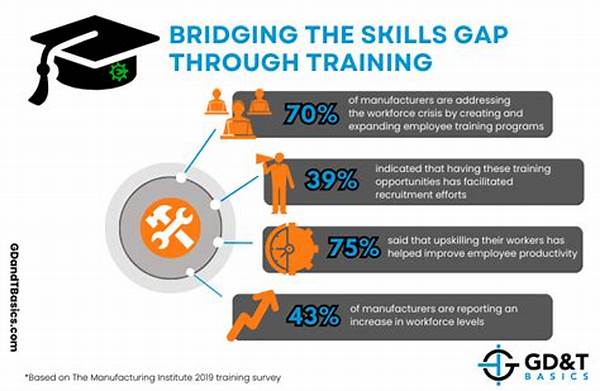Once upon a time, in a bustling city filled with businesses and hopeful individuals eager to succeed, there lived a young professional named Alex. Alex, like many others, faced the daunting task of navigating a rapidly evolving job market. With technology advancing at breakneck speed, Alex felt the familiar sting of the skill gap. It seemed like every listing asked for talents just beyond reach. But Alex wasn’t alone. Entire companies faced the same struggle: how to prepare their workers for the jobs of tomorrow.
Read Now : Artistic Climaxes In Live Shows
Understanding the Challenge
In the heart of the city, businesses began to see the domino effect of these skill gaps. Projects stalled, innovation slowed, and frustration grew among teams. Employers started to notice that traditional methods of training couldn’t keep up with the rapid pace of technology and market changes. This realization sparked an urgent quest for solutions. The answer lay in bridging skill gaps through targeted training initiatives. Companies started investing in employee development; they crafted specific programs designed to address the evolving needs of their workforce. These initiatives tailored learning experiences to match both current industry trends and employee ambitions, creating a win-win situation. For the Alexs of the world, these programs provided hope and the tools necessary to thrive.
Strategies for Effective Training
1. Personalized Learning Paths: Alex found themselves on a journey that was uniquely theirs. Bridging skill gaps through targeted training initiatives allowed customization in learning, leading to a direct impact on their career progress.
2. Real-World Application: These initiatives revealed that learning didn’t have to be confined within four walls. By implementing real-world scenarios, the bridging of skill gaps through targeted training became a tangible reality.
3. Continuous Feedback Loops: As Alex progressed, feedback became a pivotal part of their learning curve. It enriched their experience, ensuring that skill gaps were addressed efficiently through targeted training initiatives.
4. Technology Integration: By marrying technology with learning processes, bridging skill gaps through targeted training initiatives became seamless and more engaging.
5. Collaborative Environments: Alex enjoyed learning from peers. The sense of community that these initiatives fostered helped in bridging skill gaps effectively and strengthened team dynamics.
Investing in Tomorrow’s Workforce
In a conference room filled with eager faces, company leaders gathered to discuss the next steps. They were committed to bridging skill gaps through targeted training initiatives. Across industries, a movement was growing, pushing for the realization that the future workforce depended on today’s training investments. Leaders recognized that to maintain a competitive edge, consistent upskilling was necessary. Through storytelling techniques, training sessions morphed into compelling narratives where employees like Alex became heroes of their own learning journeys.
Beyond just filling gaps, this approach empowered individuals, unlocking creativity and innovation. The companies that embraced these training initiatives not only enhanced their productivity but also witnessed higher employee satisfaction and retention. Alex and their colleagues felt valued, their growth celebrated in a culture of continuous learning. As the city adapted to these changes, it became a hub of innovation, attracting talent eager to learn and evolve.
Examples of Success
1. Alex’s journey was filled with challenges. Yet, through bridging skill gaps through targeted training initiatives, they found their niche, becoming a key player in their team.
Read Now : “broadway’s Biggest Hit Analysis”
2. A small tech startup spun its wheels until it adopted such initiatives, quickly becoming a market leader by fostering an adaptable, skilled workforce.
3. Bridging skill gaps through targeted training initiatives transformed a traditional manufacturing company into a digital powerhouse, adept at navigating modern market demands.
4. Educational institutions partnered with industries, pioneering programs that directly addressed current market gaps, a testament to the success of targeted training initiatives.
5. After adopting these initiatives, a company known for its high turnover rates saw employee satisfaction soar, proving that bridging skill gaps could indeed transform workplace dynamics.
Nurturing a Culture of Learning
The story of bridging skill gaps through targeted training initiatives is one of transformation and hope. In the face of challenges, these initiatives will not only patch the immediate gaps but will build a resilient workforce equipped for whatever comes its way. With the right training, businesses will continue to evolve, and individuals will excel. As Alex reflected on their journey, it was clear that their story was not just an individual triumph but a collective victory. Together, they crafted a future where potential knew no limits.
In every corner of the city, the seeds of change had taken root. The initiatives led to an empowered workforce, ready to tackle the demands of tomorrow. For the Alexs everywhere, this era of tailored training meant no dream was too big, no challenge insurmountable. Companies realized that success wasn’t just about navigating the present but anticipating the future, transforming today’s skill gaps into tomorrow’s achievements.
The Journey Forward
The path wasn’t always straightforward, yet for Alex and countless others, bridging skill gaps through targeted training initiatives marked the beginning of an exciting chapter. Organizations eager to advance learned that fostering a culture of continuous growth and learning was paramount. With every lesson learned and every skill acquired, these initiatives acted as the glue binding ambitious professionals to their evolving aspirations. As new challenges arose, the city buzzed with the energy of discovery, innovation, and boundless possibilities, all thanks to the power of focused training.
